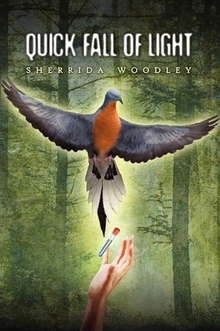Reviewed by Grant McCreary on December 24th, 2010.
In 2009, everyone was concerned about the H1N1 flu, and a few years before that, it was the threat of the Bird Flu. Honestly, it was hard for me to take the threat seriously. After all, it was just the flu? Right? Those scares, thankfully, did not blow up into full scale pandemic. But it wasn’t all that long ago when there was such a pandemic. The 1918 flu killed 50-100 million worldwide. It could happen again.
And in the novel Quick Fall Of Light, it has. A strain of bird flu is marching around the world, killing millions. The United States has not quite become an apocalyptic landscape, but communities are trying to wall themselves off while awaiting the latest anti-viral medication from the pharmaceutical corporation Colzer-Bremen.
However, the flu is not what concerns Josie. She is mourning the loss of her husband, who has recently died in a small plane crash in Washington’s Olympic forest. Needing to come to terms with her loss, she starts making her way to the spot where the plane went down. While in the forest wilderness, she encounters a logger, Gary Sterns, whom she discovers had met her husband. Sterns professes a need to show her something, so Josie follows him to a fenced-in compound hidden in the forest. He takes her up a tree, where he has constructed a small platform that allows them to look inside. Within the enclosure, she sees something amazing, something impossible.
Normally, I would consider this a spoiler and not reveal it, but it is right there on the book’s cover. If you’re reading this site, chances are you recognize that bird. It’s a Passenger Pigeon. And it’s extinct. And yet, that’s what Josie saw. From notes left behind on her husband’s laptop, Josie slowly puts together the pieces. Her husband, an ornithologist, had helped care for this flock of not-quite-extinct birds, which had been surreptitiously saved and bred. This alone would have been a major discovery, but it seems that the birds were also playing a major part in producing Colzer-Bremen’s anti-flu medicine.
Josie, accompanied by Sterns, sets out for Nebraska and the farm of an old man mentioned in her deceased husband’s notes. He alone holds the answers to the mysterious flock of pigeons, her husband’s involvement with them, and the circumstances behind his death. On their way they find that they are accompanied by an escaped Passenger Pigeon and pursued by a ruthless man from the pharmaceutical company determined to protect their interests.
Though there is a good bit of action, this is really a character-based story. Through the ordeal you have a chance to get to know Josie, Sterns, and, to a slightly lesser extent, the man pursuing them. They are, without a doubt, interesting characters and the highlight of the book.
The underlying premise, the connection between Passenger Pigeons and the flu, is an intriguing one. In the story, it is theorized that avian flu, in addition to human persecution, is what caused the (apparent) demise of the pigeons. The flu that ravaged the birds went on to become the 1918 flu, and is also related to the modern-day variety infecting the world. This allows the researchers to harvest antibodies from the living birds to use in the anti-flu medicine.
As the book’s back cover suggests, this story is very much “part Michael Crichton”. As a fan of his scientific thrillers, I found it easy to accept this storyline, but not necessarily easy to understand. I got the basic gist of it, but it wasn’t clear to me exactly how some things, particularly the anti-virus extraction process, worked. The medicine derived from the birds was in the form of percentages. Earlier runs had a lower percentage of effectiveness and they had to slowly work their way up to a 100% anti-virus. But it wasn’t clear (at least to me) why this was so. I thought this aspect of the story was a great idea, but I would have liked a more detailed and technical explanation of what was going on.
But the technical aspects were not the only things hard to understand. It was sometimes unclear what, exactly, was happening in the narrative. While I appreciate the author’s effort to elevate the prose, I found the language to be a little too abstract and “fancy”. The dialog especially seemed slightly off and unnatural. At one point, Josie says “You amaze me, but you don’t flummox me, Mr. Sterns.” Who talks like that?
Recommendation
I found Quick Fall of Light worth reading, though not as enjoyable and riveting as the novels I usually read. Its use of the Passenger Pigeon was inspired and, as a birder, the primary reason I was interested in reading it. But the non-Columbiformes were the real stars of the story. You may have to acclimate yourself to the different writhing style, but if you like character-driven novels with out of the ordinary situations, you should check out Quick Fall Of Light.
Disclosure: I get a small commission for purchases made through links in this post.
Disclosure: The item reviewed here was a complementary review copy provided by the author. But the opinion expressed here is my own, it has not been influenced in any way.



Comment